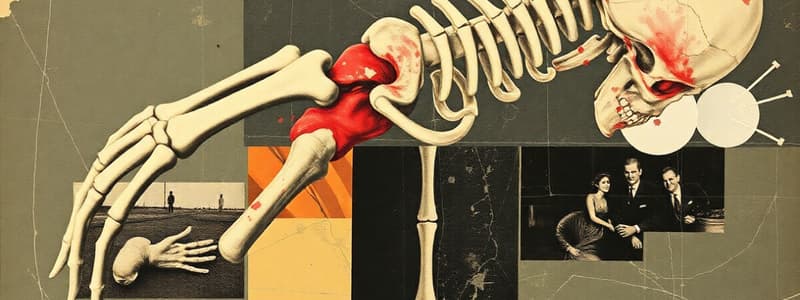Podcast
Questions and Answers
What is the primary function of ligaments in the musculoskeletal system?
What is the primary function of ligaments in the musculoskeletal system?
- Connect bone to bone (correct)
- Connect muscle to bone
- Support blood vessels
- Store calcium
Which type of fracture is characterized by the bone piercing through the skin?
Which type of fracture is characterized by the bone piercing through the skin?
- Greenstick fracture
- Compound fracture (correct)
- Simple fracture
- Comminuted fracture
What is a common complication of hip fractures in elderly populations?
What is a common complication of hip fractures in elderly populations?
- Decreased bone density
- Compartment syndrome
- Fat embolism
- Malunion (correct)
Which hormone is primarily responsible for increasing calcium levels in the blood?
Which hormone is primarily responsible for increasing calcium levels in the blood?
Which of the following is a key characteristic differentiating osteoporosis from osteopenia?
Which of the following is a key characteristic differentiating osteoporosis from osteopenia?
What is the primary systemic effect of rheumatoid arthritis?
What is the primary systemic effect of rheumatoid arthritis?
Which of the following factors can positively affect bone healing?
Which of the following factors can positively affect bone healing?
Osteoarthritis primarily affects which demographic group?
Osteoarthritis primarily affects which demographic group?
What is the main characteristic that differentiates a sprain from a strain?
What is the main characteristic that differentiates a sprain from a strain?
Which of the following factors is NOT known to affect bone healing?
Which of the following factors is NOT known to affect bone healing?
What differentiates osteoporosis from osteopenia?
What differentiates osteoporosis from osteopenia?
Which hormone plays a role in calcium homeostasis by increasing calcium reabsorption in the kidneys?
Which hormone plays a role in calcium homeostasis by increasing calcium reabsorption in the kidneys?
Which condition is characterized by the inflammatory destruction of synovial joints?
Which condition is characterized by the inflammatory destruction of synovial joints?
What is the primary complication associated with hip fractures in older adults?
What is the primary complication associated with hip fractures in older adults?
Which phase of bone healing involves the formation of a hard callus?
Which phase of bone healing involves the formation of a hard callus?
Which type of muscle is primarily affected by a strain?
Which type of muscle is primarily affected by a strain?
Which of the following best describes compartment syndrome?
Which of the following best describes compartment syndrome?
Who is the population most commonly affected by osteoarthritis?
Who is the population most commonly affected by osteoarthritis?
Flashcards
Comminuted Fracture
Comminuted Fracture
A fracture where the bone breaks into more than two pieces. Imagine a twig snapping into several pieces.
Tendonitis
Tendonitis
Inflammation of the tendon, often caused by overuse or repetitive strain. Imagine a tight rope, overworked, starting to fray.
Closed Fracture
Closed Fracture
A break in a bone, but the skin is still intact. Think of a clean break, no open wound.
Open Fracture
Open Fracture
Signup and view all the flashcards
Nondisplaced Fracture
Nondisplaced Fracture
Signup and view all the flashcards
Displaced Fracture
Displaced Fracture
Signup and view all the flashcards
Compartment Syndrome
Compartment Syndrome
Signup and view all the flashcards
Malunion
Malunion
Signup and view all the flashcards
Bone functions
Bone functions
Signup and view all the flashcards
Bone cell types
Bone cell types
Signup and view all the flashcards
Bone growth and remodeling
Bone growth and remodeling
Signup and view all the flashcards
Ligaments
Ligaments
Signup and view all the flashcards
Sprains
Sprains
Signup and view all the flashcards
Strains
Strains
Signup and view all the flashcards
Parathyroid hormone (PTH) role in calcium homeostasis
Parathyroid hormone (PTH) role in calcium homeostasis
Signup and view all the flashcards
Vitamin D role in calcium homeostasis
Vitamin D role in calcium homeostasis
Signup and view all the flashcards
Organs involved in calcium homeostasis
Organs involved in calcium homeostasis
Signup and view all the flashcards
Study Notes
Musculoskeletal Trauma
-
Basic concepts of the musculoskeletal system
- Describe main functions of bones
- Differentiate types of bone cells
- Describe bone growth and remodeling processes
- Differentiate ligaments and tendons
-
Basic pathophysiologic concepts of musculoskeletal trauma
- Differentiate between a sprain and a strain
- Bone fractures (explain 7 types)
- Bone healing (understanding phases and factors affecting healing, including malunion, delayed union, nonunion)
- Complications of fractures (malunion, delayed union, nonunion, compartment syndrome, fat embolism, avascular necrosis (AVN))
- Compartment syndrome, fat embolism, AVN (note that compartment syndrome is an emergency)
-
Pathophysiology of selected disorders (musculoskeletal trauma)
- Hip fracture (identify population at risk, complications, and specific symptoms)
- Identify the population most at risk for hip fracture
- Identify complications of hip fracture
Degenerative Disorders of the Musculoskeletal System
-
Basic concepts of health bone and joint function
- Role of bone in calcium homeostasis
- Functions of parathyroid hormone and vitamin D in calcium homeostasis
- Organs/tissues involved in calcium homeostasis
-
Pathophysiology of selected degenerative bone and joint disorders
- Osteoporosis/osteopenia
- Pathophysiology, symptoms, risk factors, complications (mention leading to specific symptoms)
- Differentiate between osteoporosis and osteopenia
- Osteoarthritis (OA)
- Population most commonly affected
- Pathophysiology and symptoms (mention S/Sx)
- Rheumatoid arthritis (RA)
- Pathophysiology and symptoms (mention S/Sx)
- Systemic autoimmune disease
- Compare and contrast RA and OA (include key differences)
- Osteoporosis/osteopenia
Studying That Suits You
Use AI to generate personalized quizzes and flashcards to suit your learning preferences.




